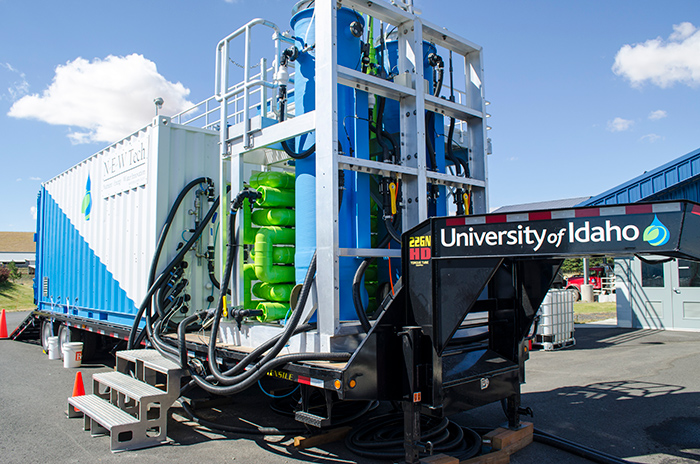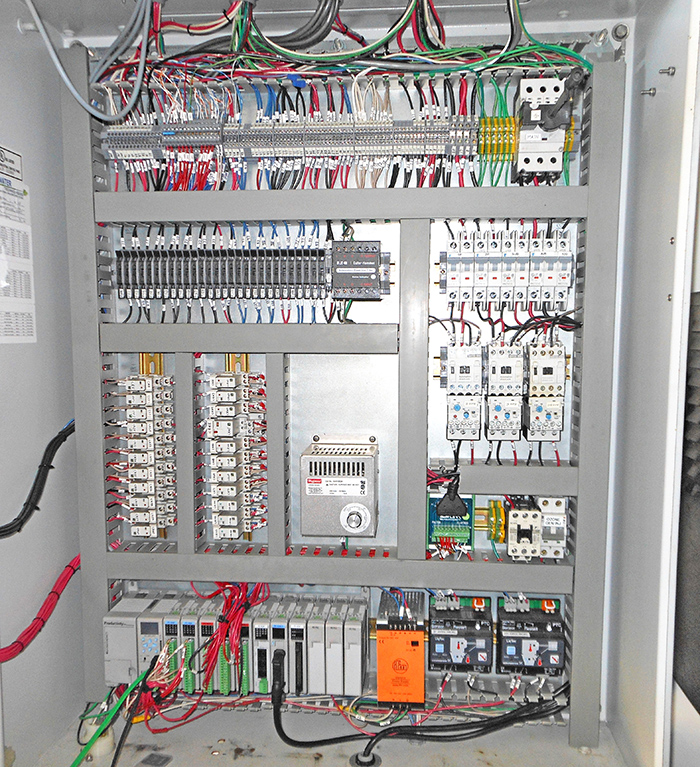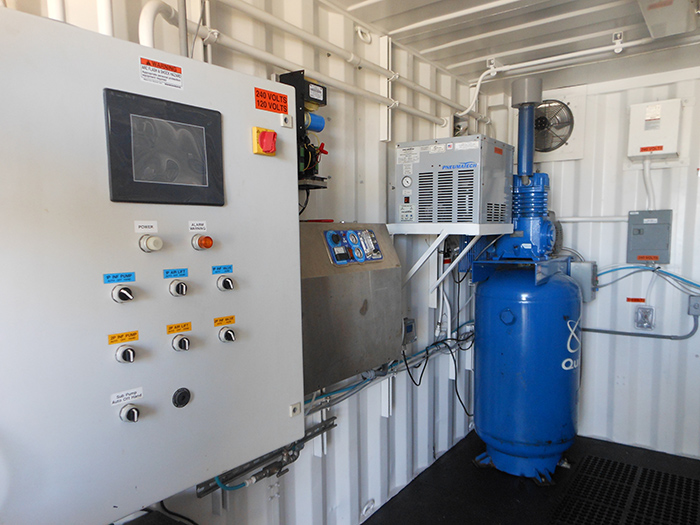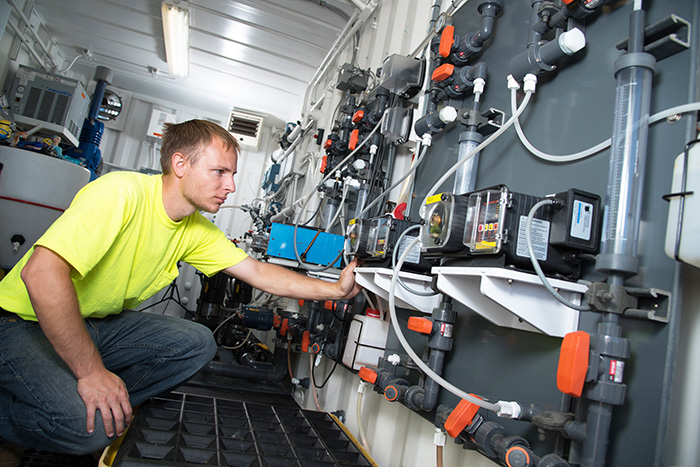The purpose of the research wastewater treatment process trailer is to test water treatment technologies (see Image 1). Specifically, this nine-ton, 40-foot-long process trailer confirms the possibility of renewable water reuse through water contaminant destruction, water sterilization and other water treatment tools. The system can also use biochar from biomass energy production to clean water.
The system removes nutrients and recovers phosphorus when treating dirty water to supply reusable water. Reactive water filtration is used with functionalized biochar as a catalyst, with ozone used for catalytic oxidation.
 Image 1. The 40-foot research water treatment process trailer, designed and built by the University of Idaho, provides wastewater treatment using a series of reactors and filters. (Images courtesy of AutomationDirect)
Image 1. The 40-foot research water treatment process trailer, designed and built by the University of Idaho, provides wastewater treatment using a series of reactors and filters. (Images courtesy of AutomationDirect)This article looks at some of the science and methods used to move effluent through the process.
Biochar & Catalytic Oxidation
An important part of this process is the biochar catalyst, which is like activated charcoal used in inline water filters. When looking at biochar science, there are eco-friendly, sustainable advantages. Since it is recovered from plant life and not fossil fuels, the biochar biomass energy is carbon neutral. Also, the biomass carbonization process can produce liquid fuels, and the heat created during production of biochar can generate energy. Because the biochar helps trap water and nutrients in the soil, agricultural productivity can be increased.
Part of the process includes catalytic ozone oxidation, which provides destructive removal of many organic contaminants in wastewater, such as hormones and antibiotics. This oxidation also can destroy microbial life such as bacteria, viruses and prions.
 Image 2. A PLC, mounted at the bottom of the panel, provides scalable hardware and software for monitoring and control of the wastewater treatment process.
Image 2. A PLC, mounted at the bottom of the panel, provides scalable hardware and software for monitoring and control of the wastewater treatment process.The mineralized phosphorus, nutrients and nitrogen are removed from the water when they bind to the biochar during the process. The resulting byproduct is a nutrient-rich biochar that can be turned into fertilizer pellets. The entire advanced water treatment process is carbon negative when the nutrient-enhanced biochar is used as a fertilizer, trapping its carbon in soil for about 200 years.
Equipment Process Steps
The portable water treatment process trailer was built on a 40-foot flatbed trailer and includes a 20-foot metal shipping container housing the instrumentation and process controls.
The container also includes the pumps, valves, ozone generator, air compressor and air dryer used in the process. Sample ports, testing equipment and a control enclosure are also housed in the container.
This complete water-treatment process training and research platform includes chemical dosing, main fluid flow, and air and ozone fluid flow systems. The external process control system includes a pair of interlaced lime green plug-flow reactors that perform the treatment, and a pair of blue catalytic filter towers (see Image 1).
Each 45-foot plug-flow reactor is followed by a catalytic filter tower—a self-cleaning moving bed reactive sand filter. Small doses of functionalized biochar and ozone are metered into the first reactor, with sand in the first filter made highly reactive to remove trace contaminants.
Precise amounts of ozone and metal salts are pumped into the second reactor effluent for high efficiency water polishing. At the output, the byproducts, phosphorus and nitrogen bound to biochar, are recovered for use as fertilizer. The effluent then moves through the second sand filter where the water is polished again. The output of this filter is clear, clean water.
 Image 3. Touch panel HMI. An HMI is used for data logging and operator interface functions.
Image 3. Touch panel HMI. An HMI is used for data logging and operator interface functions.This research trailer processes approximately 15 gallons per minute (gpm). The primary water pumps in the main trailer are driven by 1.5 horsepower (hp) single-phase motors, operating each of the reactive filters used in series. These vertical multistage centrifugal pumps are capable of up to 70 gpm.
However, by scaling up the commercially proven reactive filtration process and adding larger pumps, the system could process tens of millions of gallons a day. Currently, variants of the University of Idaho reactive filtration processes are installed at water treatment plants with throughputs as large as 12 million gallons of effluent per day. At these flow rates, treatment of a broad range of municipal, agricultural and industrial wastewater becomes viable.
Scalable Control Hardware
Not only can the process be scaled, the control system can as well (see Image 2). The control enclosure, housing the programmable logic controller (PLC) and human machine interface (HMI) can handle a much larger process. Increasing the size and duplicating some of the power distribution components, motor and drives could enable pumping and treating millions of gallons of effluent per day.
The process is automated with the PLC for motor control, opening and closing valves, operating pumps, and metering biochar and ozone. The PLC also monitors flow and level for process signal control and sampling operations. The process treatment sample sensors included pH, redox, dissolved ozone, head-loss, turbidity and total organic carbon.
The process control hardware also provides supervisory control and data acquisition for the process trailer, and includes wireless streaming capability. The controller technology offers a modular, rack-based system with extensive discrete, analog and specialty I/O module options. The high-performance CPU has the memory, I/O capacity, communication ports and scan times needed for the current process, and for a larger scaled-up process.
Data Logging
Data logging is a vital part of this process and the related research activities. Significant amounts of data are logged using the controller and the HMI. The controller provides up to 32 GB of data storage using a standard microSD card. Users access the controller’s built-in web server using any browser to view, download or delete data log files.
 Image 4. Reagent metering pump system. The critical reagent preprocessing pump system feeds the reactors, and is controlled and monitored by the PLC.
Image 4. Reagent metering pump system. The critical reagent preprocessing pump system feeds the reactors, and is controlled and monitored by the PLC.The touch panel HMI communicates with the PLC using a serial port connection, providing operator monitoring and control of the process (see Image 3). The 8-inch color, touch panel HMI display includes Ethernet and USB ports. This unit also provides data logging and web server functionality. This system logged certain data to a USB pen drive connected to the USB port.
Pumping with 3-D Parts
Stepper motors and microstepping drives are used to preprocess the biochar before it is fed into the influent water (see Image 4). Peristaltic pumps are used in this reagent preprocessing system, and are capable of a max feed of 0.96 gallons per hour and a max pressure of 100 psi.
Since commercially available biochar is available in three forms—powdered, slurry and suspension—a creative approach was needed to pump and meter the biochar. Depending on the biochar type, different 3-D printed parts are connected to the stepper motors, each of which is controlled with a high-speed pulse output module in the PLC rack.
A simple stepper motor–driven auger feeds the biochar when the powder form is used. In the slurry suspension form, the biochar-water mixture is mixed using a pair of paddles, and a diaphragm pump precisely feeds the material into the influent water. This process uses a diaphragm metering pump controlled by a variable frequency drive (VFD). With a 3/8-inch pipe connection, this 1/3 hp pump has an output range of 0.5 to 5 gpm at a max pressure of 300 psi.
A range of reactive filtration technologies from the University of Idaho is achieving research and commercial success for municipal and industrial wastewater treatment applications. Systems using these technologies have been installed across the United States and in several other countries.


